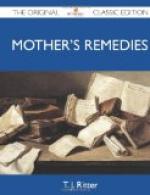At a church wedding in the country the bride’s friends must come to the rescue, and their gardens be robbed to beautify church and home. Flowers may be sought in the fields. Large jars of daisies, wild ferns, tall grasses, autumn tinted boughs, or in the blooming season, boughs of fruit trees, can be used most effectively. At one pretty home wedding the decorations were boughs of the wild crab-apple in bloom, pink and pretty, and kept so by having the stems inserted in bottles of water, suspended by wires and concealed by other foliage. A large screen sometimes forms a background for the bridal party. If covered with wire netting flowers can be very easily attached.
Walls are not festooned; “wedding bells” and canopies are out of date. The most approved setting is tall palms, ferns on standards concealed by a lower grouping, with a few potted plants in bloom to relieve the sombreness of the green. Large flowers like lilies, hydrangeas, chrysanthemums and peonies are most effective. Tulips are often employed at a spring wedding. One little country girl made good use of ordinary field clover in decorating her home for her marriage.
After a wedding, the flowers are often sent to the hospitals, or to those who are known to be ill, at the request of the bride.
THE SIMPLEST OF WEDDINGS.
Now, although we have told how the church wedding and the ordinary home wedding are conducted, it does not follow that one may not have a much simpler and yet a pretty wedding, with less “pomp and circumstance” and consequent expense.
Wherever a girl has a home, she should be married from it. This is her due, as “daughter of the house.”
She may make the simplest possible preparations; may be married in her best dress, not new for the occasion. She may omit all attendants, and invite less than half a dozen of her friends; she may receive them herself and at the appointed hour simply stand up and be married to a blushing young man in a business suit, and afterwards cut her own cake, and then proceed to her new home, which may be a little flat or a cottage. But she should have the ceremony performed by a clergyman in her father’s house.
If she has no parents, no home, merely a room in a boarding house, she and her affianced may go to a clergyman’s house and be married there. The church and the law should sanction the rite; therefore she will not permit herself to be married by a magistrate or a justice of the peace.
As for “sneaking off” and being married without the knowledge of one’s parents, this is both disrespectful and unkind—a poor return for their care of her.
[Manners and social customs 745]
Wedding anniversaries.
The fashion of celebrating a succession of wedding anniversaries has passed its high tide and is on the wane. Nevertheless, the custom is not out, by any means. The tenth, twenty-fifth and fiftieth anniversaries, known as the tin, silver, and golden, are those most frequently observed.




